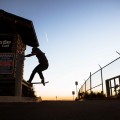Chance Gaul with a golden-hour stale fisher.
WORDS & PHOTOS David Marano
The similarities between skating transition and surfing a wave are very close—you ride up the surface and back down again, ya hit the lip, rotate, shimmy, boost, tweak, and/or contort your board and body as you see fit. That said, there’s also a subtle and rather distinct difference in the rate of change in the surface and texture of a waves as apposed to the mostly static and predictable surface of a ramp, bowl, or even a winding mountain road. The same ramp or hill you skated the day before will be there the next morning much as it was when you last ripped it—same transitions and same surface. On the other hand, a wave is in constant flux; day-to-day, hour-to-hour, wave-to-wave. Winds, tides, and swell direction all play into the way a wave is shaped and how it’s transition and texture is effected. Now I’m not saying that a ramp, bowl, spot, or hill will not change/deteriorate with time or from exposure to various elements; but waves are much more vulnerable to elemental and perpetual attacks on their quality. Basically, surf spots are much more fickle than skate spots and this posses a distinct set of challenges, and of course opportunities too.
Chance, getting out and over in Laguna.
Going to a skate park shapes the way I surf, and visa-versa. All the action sports I do help with the next. -Chance Gaul
That waiting game every surfer knows well.
The closest a wave can get to having the exact same transition as the one before it is through a reef or a point break. Sand bottoms shift, so beach breaks rarely see the benefits of a wave doing it’s thing in the same exact spot every time, or even offering up the same lip (similar to pool coping or the camber in a corner of a mountain run). With reefs, a wave will break on that particular cut of rock at the same spot, and typically the transition will be similar to the wave before it, but not exactly perfect. No wave is exactly the same. I once was told, every wave has it’s own fingerprint. That’s a bit deep, bro! Ha ha! But yeah, talk to any top surfer and they’ll say the best surf spots to practice surfing are the waves that break on reefs—a similar section or transition is constantly present. You can, for the most part, know what to expect and how to react. These days, as many new surfers are also passionate skateboarders of varied disciplines, we see many of them fusing what they’ve learned from skating and carrying those skills back into the water. Many of these “surf-and-turf” rippers have suggested that skating provides that perfect “break” to practice on, and thus helping hone skills—because you can most always count on the same transition and surface. Which brings us back to my original ideas that skating is in most cases more predictable in terrain overall. And there’s nothing wrong with that, as “practice makes perfect”, and skating makes that available all day long, most everyday. I’ve always believed that the progression of surfing will come from the kids who grow up skating and putting that knowledge, confidence, and practice out into the water. The understanding and benefits that skating gives us via an unaltered transition, over and over again, is elemental in helping transform ideas into perfection, or close to it. That’s one of the reasons skating is so badass and continues to have endless possibilities—and for dudes who also surf, doubly so!
Laguna Beach is a downhill wonderland. Chance knows wassup!
Chance getting frothed “jetty-style” in Newps while the bikini babes watch the action unfold.
Chance, in between runs on his local mini ramp.
Chance Gaul is definitely one of those dudes who feeds off his skating and puts that into his surfing, and visa-versa. He skates it all, from downhill, to bowls, to mini-ramps, and I can tell just from watching him surf or skate, both thrive off the other. And he knows, “Going to a skate park shapes the way I surf, and visa-versa.” I’m stoked to see the future of surfing and skating mixing in with each other. As I said before, much of the progression in surfing is coming from kids who understand the similarities between skating and surfing and in turn actively grow this connection. They use what they’ve learned out in the water, or from a mini-ramp session and they take those techniques and use them to help grow the other side of the spectrum. Both surfing and skating will always lean on each other for style. Surfing and it’s progression will come from skating and its’ more fixed landscape of transitions and bowls to practice and evolve around. By the same token, skating has and always will hold fluidity and flexibility to a very high regard—surfing and the ever-changing unpredictability of riding waves will always foster such opportunities.
-David Marano

